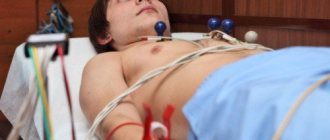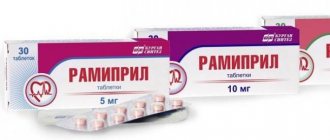LESSON 2 (Sinus-non-sinus)
The next task is more difficult - determining the ECG rhythm
Considering that there are a lot of violations, we will focus only on the most basic ones, but first you need to learn to distinguish sinus rhythm from non-sinus rhythm. To do this, you need to remember, write down (who needs it) the signs of sinus rhythm.
- The presence in leads II (and usually aVF) of positive, identically shaped P waves, located at the same distance from the QRS complex in all complexes (heartbeats).
- Heart rate (I’ll tell you how to determine it later) from 60 to 100 per minute (less is bradycardia , more is tachycardia .).
- The difference between the largest and smallest RR intervals (more on intervals later) should not exceed 10%. (however, this rule only applies if the heart rate is more than 60 per minute, that is, if there is no sinus bradycardia)
As you may have guessed, to understand rhythm you need to talk about how to determine the frequency of the rhythm and intervals.
ECG INTERVALS (now we are only interested in RR)
This diagram more than clearly demonstrates how to measure the RR interval.
Note: Intervals are measured in milliseconds, for example: 750 ms or 0.75 s, but we will use a simpler method.
Knowing how to measure the RR interval, we can determine the heart rate (HR)
DETERMINATION OF HEART RATE
Regardless of the type of ECG device, the recording always contains small cells of 1 × 1 mm and large cells of 5 × 5 mm, and the speed of the tape is also indicated (this is important!), usually 50 mm/s. or 25 mm/s.
At belt speed 50 mm/s:
HR = 600 / (number of large squares between two RRs (RR interval); or HR = 3000 / (number of small squares) .
At belt speed 25 mm/s:
HR = 300/(number of large squares between two RRs (RR intraval); or 1500/(number of small squares).
Here it would be appropriate to give a little additional information about the ECG waves.
Each wave on an ECG has two characteristics: amplitude and duration.
The amplitude is expressed in mV (millivolts), usually one mV corresponds to ten mm or 10 small cells.
The duration is expressed in seconds (less often milliseconds), so one cell in a standard ECG recording (tape speed 50 mm/s) is equal to 0.02 s. When recording at a speed of 25 mm/s, one small cell is equal to 0.04 s.
Let's try to use this formula together (by the way, it was not taken from our heads, but is derived mathematically, but let's not talk about that)
EXAMPLE ECG No. 1
CALCULATION: tape speed is 50 mm/s, select any lead where there are high R waves, let it be II.
We take the first RR - it is equal to almost 9 large cells, which means: heart rate = 600/9 = 66 beats. per minute
Or, RR is equal to 45 small cells, then: heart rate = 3000/45 = 66 beats. per minute That's all.
As you can see, the numbers almost coincided with those calculated by the computer; this technique is used to determine heart rate “by eye.” In practice, it is convenient to use special cardiac rulers.
But let's make it more difficult.
Example ECG No. 2
As you can see, the rhythm frequency varies from 63 to 84, what should you do in this case?
The easiest way is to take 3-4 intervals and find the arithmetic mean, that is: (59+64+80+84)/4 = 72 beats. per minute
At this point, we will consider the topic “heart rate” closed, and we return to our plan, namely:
PQ Interval and PQ Segment
The PQ interval is determined from the beginning of the P wave to the beginning of the QRS complex. The PQ interval corresponds to the time it takes for an electrical impulse to travel through the atria and the atrioventricular node.
The duration of the PQ interval normally ranges from 0.12 to 0.2 s (3 to 5 mm).
Diagram 3. Interval and PQ segment
In diagram 3 on the right, the interval and segment PQ are marked in different colors.
The PQ segment is defined from the end of the P wave to the beginning of the QRS complex. The PQ segment corresponds to the time when the atria are completely covered by the excitation wave, and the excitation of the ventricles has not yet begun. At this moment, a pause occurs: there are no changes in the electric field of the heart, so the PQ segment is located on the isoline. The pause is associated with a delay in the passage of the electrical impulse through the atrioventricular node to the ventricles.
The physiological meaning of this pause is that at this time the atria are fully contracted and push blood into the relaxed ventricles. Subsequently, excitation and contraction of the ventricles and release of blood into the systemic and pulmonary circulation will occur (the QRS complex is recorded on the cardiogram).
How to determine sinus rhythm?
We are a little distracted from the plan, if you remember (who doesn’t remember, let’s go up) one of the signs of sinus rhythm is:
The presence in leads II and aVF of predominantly positive, identically shaped P waves, located at the same distance from the QRS in all complexes (heartbeats).
Let's look at an example:
Example ECG No. 3
As you can see, in leads II, AVF, positive P waves of the same shape are quite clearly defined. They are also located at the same distance from the ventricular QRS complex (in this case there is no S wave, therefore qR) are marked with black markers. The first condition is met.
Second condition : heart rate = 60-100 per minute. As you can see, the frequency here is about 68-70 rpm. Done
The third condition is that the difference between the two RRs does not exceed 10%. What does it mean? Return to ECG No. 2, on it the rhythm frequency varied from 59 to 84, that is, the difference between the two numbers (84-59) = 25. In order to understand what this difference looks like as a percentage, you need to create a proportion: (100 × 25/84) = 29% (direct proportion, school program), which means the third condition is not met and the rhythm on ECG No. 2 is not sinus. When all conditions are met, but the RR difference exceeds 10%, this is called sinus arrhythmia.
Ventricular depolarization - QRS complex
From the atrioventricular node, the excitation wave propagates through the conduction system of the ventricles. This causes depolarization (excitation) of the ventricles. The ventricular QRS complex is recorded on the cardiogram at this time.
In diagram 4 on the left, the propagation of the excitation wave through the ventricles is shown in yellow; the red color shows that at the same time repolarization (restoration) of the atria occurs. On the right side of diagram 4, the ECG highlights the QRS complex, which is recorded during this period. Atrial repolarization is not visible on the cardiogram due to the “overlay” on the QRS complex.
Scheme 4. Ventricular depolarization and formation of the QRS complex on the cardiogram
The parameters of the QRS complex are normal:
- The QRS duration ranges from 0.07 to 0.1 s (1.5 to 2.5 mm).
- The QRS amplitude must be at least 5 mm in at least one limb lead, and more than 8 mm in at least one chest lead.
- The QRS amplitude in the limb leads should not exceed 22 mm, and 25 mm in the chest leads.
Q wave
The Q wave of the QRS complex reflects excitation of the interventricular septum. This is a non-permanent ECG wave. Normally, the Q wave may be recorded or absent in the limb leads and in the chest leads V4-V6. Registration of Q in leads V1-V3 always indicates pathology.
Normal Q wave parameters:
- Q depth < 2 mm in leads I, II, aVL, aVF, V4-V6.
- The Q depth may be more than 2 mm in leads III, aVR.
- Width Q < 1 mm.
ECG 2. Examples of a normal Q wave in leads II and III
Parameters of the pathological Q wave:
- Q depth > 2 mm, and also if the amplitude of the Q wave exceeds 25% of the amplitude of the following R wave.
- Width Q > 1 mm.
- Any Q in leads V1-V3 is considered pathological.
The presence of a pathological Q wave on the cardiogram usually indicates myocardial infarction.
ECG 3. Examples of pathological Q wave and ST segment elevation in leads II and III
R wave
The R wave reflects the initial stage of depolarization (excitation) of the ventricles. The amplitude R in the limb leads is determined by the position of the EOS. In the chest leads, the amplitude R increases from V1 to V4, and then in V5 and V6 it becomes smaller. Normally, especially in young people, the r wave may be absent in leads V1, V2. In this case, QRS type QS is recorded on the ECG. However, in this case there should be caution, because the QS complex may be a manifestation of myocardial infarction.
S wave
The S wave reflects the final stage of ventricular depolarization - excitation of the base of the left ventricle. This is a non-permanent ECG wave. In the chest leads, the S wave usually has its greatest amplitude in V1-V2, which decreases towards V5-V6.
Waves, segments and intervals on the ecg. Pay attention to large and small cells (more about them below).
QRS complex waves
Since the ventricular myocardium is more massive than the atrial myocardium and has not only walls, but also a massive interventricular septum, the spread of excitation in it is characterized by the appearance of a complex QRS
on the ECG.
How to correctly identify the teeth in it
?
First of all, the amplitude (size) of individual teeth
QRS complex.
If the amplitude exceeds 5 mm
, the tooth is designated by
a capital (capital) letter
Q, R or S;
if the amplitude is less than 5 mm, then lowercase (small)
: q, r or s.
A wave R (r) is any positive
(upward) wave that is part of the QRS complex.
If there are several waves, subsequent waves are designated by strokes
: R, R', R”, etc. The negative (downward) wave of the QRS complex, located
before the R wave
, is designated as Q (q), and
after - as S
(s) .
If there are no positive waves at all in the QRS complex, then the ventricular complex is designated as QS
.
Atrial depolarization - P wave
From the sinus node, the electrical impulse spreads through the right and then through the left atrium. During this period, the ECG records the P wave, which reflects the excitation of the atria.
In diagram 2 on the left, the spread of excitation from the sinus node through the atria is shown in yellow, and the P wave, which corresponds to this process, is highlighted on the right of the ECG.
Scheme 2. Formation of the P wave on the cardiogram
Normal P wave parameters:
- The P wave is located in front of the QRS complex.
- The P wave is positive in lead II.
- In lead aVR the P wave is negative.
- In V1, the P wave can be positive or biphasic.
- In other chest leads the P wave is positive.
- P wave amplitude < 0.25 mV (2.5 mm). If P wave height > 0.25 mV (2.5 mm), this indicates an abnormality.
- P wave duration <0.12 s (3 mm). If the duration of the P wave is > 0.12 s (3 mm), this indicates an abnormality.
ECG 1. Positive P wave in leads I, II, negative in aVR and biphasic in V1
ST segment
The ST segment is determined from the end of the QRS complex to the beginning of the T wave. This period corresponds to the time when the ventricles are completely covered by the excitation wave, and their relaxation (repolarization) is just beginning.
Scheme 5. Formation of the ST segment
The point at which the QRS becomes ST is called the J point.
An increase or decrease in the ST segment relative to the isoline may be associated with ischemia, infarction, or other pathology. The deviation of ST from the isoline is usually measured at the J point, as well as at the ST60 point (at a distance of 0.06 s or 1.5 mm from the J point) and at the ST80 point (at a distance of 0.08 s or 2 mm from the J point).
The following ST segment deviations are considered acceptable (normal).
- ST depression measured at the J and ST80 points should normally be less than 0.5 mm in V2-V3 and less than 1 mm in the remaining leads.
- ST elevation measured at points J and ST80 should normally be less than 2 mm in V2-V3 and less than 1 mm in other leads.
ECG 2 above shows fragments of leads II and III with a normal ST segment location. ECG 3 in the same leads recorded ST elevation in combination with pathological Q, which indicates the development of infarction of the lower parts of the left ventricle.
The issues of the position of the ST segment in relation to the isoline and the diagnostic assessment of different types of depression or ST elevation are discussed in more detail in other sections.










